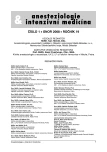New trends in the clinical research of microcirculation
Authors:
Z. Turek; V. Černý
Authors‘ workplace:
Klinika anesteziologie, resuscitace a intenzivní medicíny, Univerzita Karlova v Praze, Lékařská fakulta v Hradci Králové, Fakultní nemocnice Hradec Králové
Published in:
Anest. intenziv. Med., 19, 2008, č. 1, s. 9-11
Category:
Intensive Medicine
Overview
The structural and functional pathology of microcirculation is the crucial mechanism of the development of various types of diseases especially sepsis and other types of distributive shock. Intensive progression in microcirculatory research including pathophysiological relationships and a unique opportunity to visualize microcirculation at the bedside produced a lot of new results, but their comparability and exact interpretation are extremely difficult due to incomparable methods in the recent clinical studies. Several key points for image acquisition and analysis were identified: 3–5 sites per organ, elimination of pressure-induced artefacts, appropriate focusing, contrast and resolution settings and uniform quantitative description of the microcirculatory status using the perfused vessel density (PVD) and the microcirculatory flow index (MFI). The influence of some chronic coexisting diseases on the function and structure of microcirculation is under intense investigation. New aspects of incoming clinical microcirculatory research are discussed in this short review.
Keywords:
microcirculation
Sources
1. Groner, W., Winkelman, J. W., Harris, A. G., Ince, C., Bouma, G. J., Messmer, K., Nadeau, R. G. Orthogonal polarization spectral imaging: a new method for study of the microcirculation. Nat. Med., 1999, 5, p. 1209–1212.
2. Cerny, V., Turek, Z., Parizkova, R. Orthogonal polarization spectral imaging. Physiol. Res., 2007, 56, 2, p. 141–147.
3. Ince, C. Sidestream dark-field (SDF) imaging: an improved technique to observe sublingual microcirculation. Crit. Care, 2005, 8 (suppl), p. 72.
4. De Backer, D., Creteur, J., Preiser, J. C., Dubois, M. J., Vincent, J. L. Microvascular blood flow is altered in patients with sepsis. Am. J. Respir. Crit. Care Med., 2002, 166, p. 98–104.
5. Sakr, Y., Dubois, M. J., De Backer, D., Creteur, J., Vincent, J. L. Persistent microvasculatory alterations are associated with organ failure and death in patients with septic shock. Crit. Care Med., 2004, 32, p. 1825–1831.
6. De Backer, D., Creteur, J., Dubois, M. J., Sakr, Y., Koch, M., Verdant, C., Vincent, J. L. The effects of dobutamine on microcirculatory alterations in patients with septic shock are independent of its systemic effects. Crit. Care Med., 2006, 34, p. 403–408.
7. De Backer, D., Verdant, C., Chierego, M., Koch, M., Gullo, A., Vincent, J. L. Effects of drotrecogin alfa activated on microcirculatory alterations in patients with severe sepsis. Crit. Care Med., 2006, 34, p. 1918–1924.
8. Mathura, K. R., Vollebregt, K. C., Boer, K., De Graaff, J. C., Ubbink, D. T., Ince, C. Comparison of OPS imaging and conventional capillary microscopy to study the human microcirculation. J. Appl. Physiol., 2001, 91, p. 74–78.
9. Boerma, E. C., Van Der Voort, P. H., Ince, C. Sublingual microcirculatory flow is impaired by the vasopressine-analogue terlipresin in a patients with catecholamine-resistant septic shock. Acta Anesthesiol. Scand., 2005, 49, p. 1387–1390.
10. Puhl, G., Schaser, K. D., Vollmar, B., Menger, M. D., Settmacher, U. Noninvasive in vivo analysis of the human hepatic microcirculation using orthogonal polarization spectral imaging. Transplantation, 2003, 75, p. 756–761.
11. Puhl, G., Schaser, K. D., Pust, D., Kohler, K., Vollmar, B., Menger, M. D., Neuhaus, P., Settmacher, U. Initial hepatic microcirculation correlates with early graft function in human orthotopic liver transplantation. Liver Transpl., 2005, 11, p. 555–563.
12. Boerma, E. C., Van Der Voort, P. H., Spronk, P. E., Ince, C. Relationship between sublingual and intestinal microcirculatory perfusion in patients with abdominal sepsis. Crit. Care Med., 2007, 35, p. 1055–1060.
13. De Baker, D., Hollenberg, S., Boerma, E. C., Goedhart, P., Buchele, G., Ospina-Tascon, G., Dobbe, I., Ince, C. How to evaluate the microcirculation? Report of a round table conference. Crit. Care, 2007, 11, R101.
14. Trzeciak, S., Dellinger, R. P., Parrilo, J. E., Guglielmi, M., Bajaj, J. Early microcirculatory perfusion derangements in patients with severe sepsis and septic shock: Relationship to hemodynamics, oxygen transport, and survival. Ann. Emerg. Med., 2007, 49, p. 88–98.
15. Boerma, E. C., Mathura, K. R., Van Der Voort, P. H., Spronk, P. E., Ince, C. Quantifying bedside-derived imaging of microcirculatory abnormalities in septic patients: a prospectice validation study. Crit. Care, 2005, 9, p. R601–R606.
16. Hodnett, B. L., Hester, R. L. Regulation of muscle blood flow in obesity. Microcirculation, 2007, 14, p. 273–288.
17. Frisbee, J. C. Obesity, insulin resistance and microvessel density. Microcirculation, 2007, 14, p. 289–298.
18. Rattigan, S., Bussey, C. T., Ross, R. M., Richards, S. M. Obesity, insulin resistance and capillary recruitment. Microcirculation, 2007, 14, p. 299–309.
19. Brock, R. W., Dorman, R. B. Obesity, insulin resistance and hepatic perfusion. Microcirculation, 2007, 14, p. 339–347.
Labels
Anaesthesiology, Resuscitation and Inten Intensive Care MedicineArticle was published in
Anaesthesiology and Intensive Care Medicine

2008 Issue 1
Most read in this issue
- The management of severe acute pancreatitis – state of the art
- Polyneuropathy and myopathy of critically ill patients – what’s new?
- Current treatment of sepsis in children
- Blood purification and acute renal failure: the timing, method selection and dosing of renal replacement therapy
